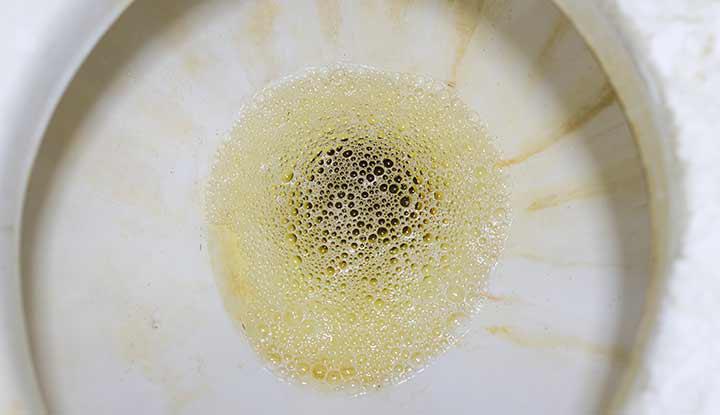Foamy Urine
Occasional instances of foamy pee are common for everyone. But sometimes, those extra bubbles in the toilet water are a sign of a more serious condition, such as diabetes or chronic kidney disease. A healthcare provider will examine a urine sample to help determine the cause and prescribe the best treatment.
Overview

What is foamy urine?
Foamy urine is when there are lots of bubbles in toilet water when you urinate (pee).
It’s pretty common for foamy urine to occur. Sometimes, when you really have to go, the speed and force of your urine stream causes lots of bubbles to appear. Or if you use a toilet cleaner, your pee may be foamy until you flush all the chemicals away. Foamy urine can also be a sign of dehydration and that you should drink more water.
But if you regularly have foamy urine, or if your pee looks very foamy — think the top of a root beer float — it might be a sign that something is wrong, and you should reach out to a healthcare provider.
There are lots of different names or descriptions for foamy urine/pee. These may include:
- Foamy pee.
- Bubbly urine.
- Fizzy urine.
- Frothy urine.
How much foam in urine is normal?
It’s common to have foamy urine without it being a sign of something wrong. Bubbles may mostly or even completely cover the surface of the toilet water when you pee every once in a while. But you should reach out to a healthcare provider if this happens regularly, it takes more than one flush to get rid of all of the bubbles or the bubbles look very frothy and white.
Possible Causes
What does foamy urine indicate?
If you regularly have foamy urine or if your pee gets foamier over time, it may be a sign that there’s a high level of protein in your pee (proteinuria). Excess protein in your pee can be a sign of conditions that directly affect your kidneys, such as diabetes or lupus. It may also indicate chronic kidney disease (CKD).
What stage of kidney disease is foamy urine?
The early stages of chronic kidney disease usually don’t have noticeable symptoms. But if you have symptoms, they usually relate to the specific type of kidney damage you have. So, for instance, if you have high levels of protein in your urine, you may have foamy urine in stage 2 CKD.
Is foamy urine diabetes?
Foamy urine can sometimes be a symptom of diabetes-related nephropathy. If your blood sugar (glucose) levels are too high often or for a long time, it can damage parts of your kidneys and affect how well they filter glucose and protein from your blood. This can cause foamy urine.
Can dehydration cause foamy urine?
Yes, dehydration can cause foamy urine. Healthy urine should be light yellow, like the color of lemonade. If you have foamy urine and your pee is darker yellow, it’s a good idea to drink fluids — preferably water.
Are there any other common causes of foamy urine?
Yes. Other causes of foamy urine include:
- Retrograde ejaculation. This is when semen pushes back into your bladder upon ejaculation instead of out through your penis.
- Amyloidosis. Amyloidosis is when the proteins in your body mutate. It can affect your kidneys.
- Urinary tract infection (UTI) medications, including phenazopyridines. Phenazopyridine helps relieve UTI pain.
Care and Treatment
How do you fix foamy urine?
A healthcare provider will first order a urinalysis to examine your pee and help determine the cause of foamy urine. Treatment depends on the cause:
- Dehydration. Drinking plenty of water is the best way to treat dehydration.
- Diabetes. Diabetes treatment varies. But it generally includes monitoring your blood sugar, taking oral diabetes medication, taking insulin, following diabetes-friendly food patterns for you, and physical activity.
- Lupus. Lupus treatment involves combinations of medications that help treat your symptoms, including hydroxychloroquine, nonsteroidal anti-inflammatory drugs (NSAIDS), corticosteroids and immunosuppressants.
- Chronic kidney disease. There’s no cure for CKD. But treatment involves minimizing further damage to your kidneys by managing your blood pressure levels, following kidney-friendly eating patterns and maintaining a weight that’s healthy for you. End-stage kidney disease treatment includes dialysis or a kidney transplant.
- Retrograde ejaculation. Retrograde ejaculation treatment may include medications. These may include imipramine and certain antihistamines, such as pseudoephedrine and chlorpheniramine.
- Amyloidosis. Amyloidosis treatment depends on the cause. But it may include targeted therapy, stem cell transplantation or organ transplantation.
When To Call the Doctor
When should this symptom be treated by a doctor or healthcare provider?
Foamy urine is common, and the causes can be harmless — maybe you had too much water to drink, or not enough. But sometimes, foamy urine may be your body’s way of telling you that something is wrong. Reach out to a healthcare provider if foamy urine lasts more than a few days, gets worse and/or appears with the following symptoms:
- Swelling (edema), especially around your hands or feet.
- Extreme tiredness (fatigue), even though you get plenty of rest.
- Nausea and vomiting.
- Loss of appetite.
- Other urine changes, including dark, cloudy or bloody (hematuria) pee.
A note from Wockr
It might be uncomfortable, embarrassing or flat-out gross for you to talk about. But everyone has foamy urine from time to time. Sometimes, there’s an easy explanation for it — you may have just cleaned the toilet, or you’ve got a strong, fast stream because your bladder is full. But if the toilet water looks extra frothy after you pee or you have foamy urine in addition to other symptoms, it’s time to have a tinkle talk with a healthcare provider. They can determine what’s causing foamy urine and figure out the best treatment.